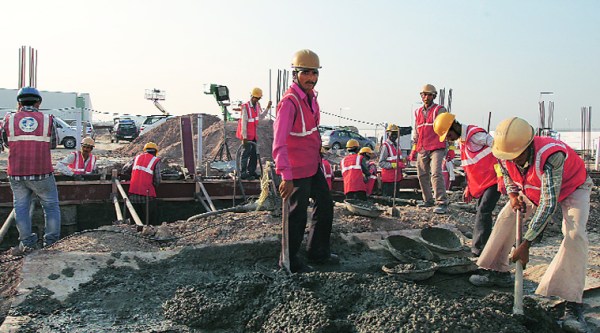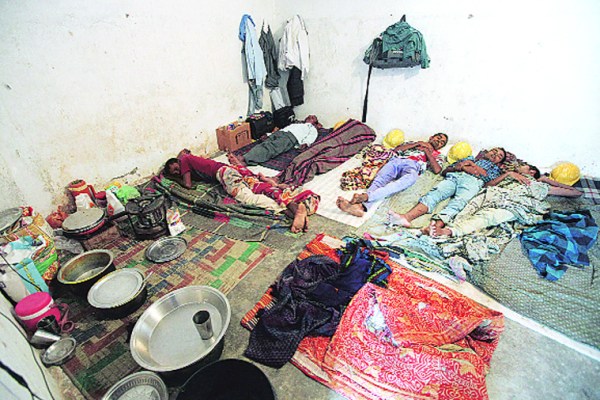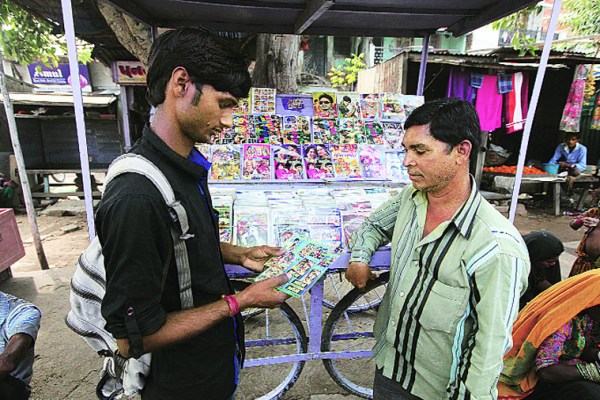- India
- International
How migrant labourers are changing the way of life in Sanand
How migrant labourers are changing the way of life in this small town near Ahmedabad.
 Migrants at work in a village in Sanand
Migrants at work in a village in Sanand
On New Year’s Eve last year, Narendra Kashyap and 20 of his friends — all migrants from Uttar Pradesh — got together and partied in their room in Mankol village near Sanand, 30 km from Ahmedabad. They watched numbers from Bhojpuri potboilers like Chhapra Express and Betaab on a DVD player, the gyrating women crooning seductively “aag laago naa…kheench lein hum dehi se rajai…” becoming an instant connect in their lonely lives with the homes they have left behind.
Kashyap, 23, who hails from UP’s Gazipur district and works as a supervisor at a firm that manufactures fiber water tanks, is one of the nearly 15,000 migrant labourers from states like UP, Bihar, Rajasthan, Jharkhand who have thronged the Sanand region over the last few years, changing the demography of the region while powering the labour demand in Gujarat’s Motown.
The eldest of four siblings, Kashyap first came to Sanand in 2009 after working in Qatar as a labourer for six months and finding himself intensely homesick. But in UP, while working as a farm labourer, money had been scarce — he used to earn only about Rs 100-150 per day — so when he heard a friend talk of the opportunities in Sanand, he decided to brave it out. “Generally, the thekedar (labour contractor) takes commission from the firm to which he provides the labour and not from the workers. I have been earning Rs 500 per day for eight hours’ work since I came to Sanand,” says Kashyap.
 Labourers resting in a colony after a hard day’s work
Labourers resting in a colony after a hard day’s work
While Kashyap and his friends live in Mankol, the major migrant centre has emerged in Bol, Motipura and Shiyawada villages, some 12 km from Sanand town. These are the villages that are included in the Sanand GIDC (Gujarat Industrial Development Corporation). In 2008, auto major Tata shifted its Nano car manufacturing plant from Singur in West Bengal to here. It was followed by Ford which has set up a huge manufacturing unit near Bol village. The arrival of these two auto giants paved the way for many auto-ancillary companies apart from FMCG, pharmaceutical and confectionery sectors. With the industrial upsurge came the influx of the migrant labourers.
Kashyap and his colleagues live in makeshift colonies constructed by the contractor firms. These are badly-planned squalid places. Powered by diesel generators, each 10 ft x20 ft units house five to 10 labourers, while bathrooms and kitchens are common. At the entrance of each colony, there is a provision store run mostly by migrants from Rajasthan.

On Sundays, these stores and the ones in Sanand town are where the buzz is. “When we go to shop for ration, we also buy Bhojpuri CDs and DVDs,” says Kashyap. Vinod Jadav, a local vendor of CDs/DVDs from Sanand, says that the rising demand for Bhojpuri music and movies have resulted in most vendors sourcing a good collection of these. His bestsellers are the films Niravava Rickshwala, Jung, Betaab, Pratigya, Adalat, Chhapra Express and Odhaniyawali Kamal Kare, while singer Khesari Lal Yadav and actors Manoj Tiwari and Pawan Singh are the most popular.
 Checking out Bhojpuri CDs at the local market
Checking out Bhojpuri CDs at the local market
Ramesh Kumar, 21, the eldest of three siblings from Muzaffarpur district of Bihar, works at a construction site in the area. He is a loner, but music proves to be a common link between him and the other labourers. They share songs over the phone and listen to them on their off days.
Satyendra Yadav, 23, from Gopalganj district of Bihar is one of those who is never averse to working overtime. “I have come here to save money. Back home, we used to get less money and we would end up spending more. Now, in addition to the Rs 500 that we earn daily, there’s also overtime when we work in excess of eight hours,” he says.
Most of the migrant labour force in Sanand are single and live without family. Some, like Sandeep Singh, a BA third year student from UP’s Gorakhpur who is learning electric wiring as an apprentice, prefer to stay in rented accommodation that they share with five or six others. But for the few families who have shifted to Sanand, time hangs heavy. Salma Khatun, 19, from Dariabad village in UP, has been staying with her husband, Firoz, a labourer, at one of the colonies in Shiyawada village. While Firoz spends most of his time at work, Salma and her three-year-old son stay back at the colony. “I don’t like it here. We have not seen anything of the place because we never leave the colony. It’s filthy and uncomfortable. I have heard that in Mumbai, migrant labourers are being given small flats to live in by their labour contractors,” she says.
The upsurge of migrant labourers has also changed the economy of this tiny town. Known for cultivating high quality tobacco and for gold trade, now, a number of shops have begun catering to the migrants and selling everyday essentials. A large number of food joints have sprung up too that offer a spicy mishmash of food in contrast to the local Gujarati fare.
Jitu Devasi is one such trader from Rajasthan, who runs a provision store at a colony in Shiyawada village. “It takes time to set up a business in routine course. But here, it’s an easy task. Around 250 labourers live here. Where would they go to buy items of daily use? So, I have a dedicated clientele at all times,” he says. While he pays Rs 1,000 as rent to the labour contract firm which has set up the colony for power supply and accommodation, he earns between Rs 8,000-9,000 every month. Like him, Kamlesh Sirvi from Pali district in Rajasthan runs a construction hardware shop in Bol village and a booking agency for train tickets, both very popular with the migrants. For the locals too, it’s an easy way to earn money by renting out their land and properties.
However, despite the economic growth, there is simmering discontent between the locals and the migrants. In areas like Bol, Motipura and Shiyawada where the migrants outnumber the local population, locals complain of dwindling jobs. Govind Dabhi from Shiyawada says, “A small UP-Bihar has come up in our villages. Don’t our kids have any right to get employment when the very land on which it has come up has been acquired from us?”
Cultural differences too contribute to the rivalry. Many labourers say they cannot move out of the colony if they are wearing lungis or shorts. “The locals beat us up on a number of occasions when we went out of the colony wearing lungis,” says one labourer from Bol.
Mahesh Patel, deputy sarpanch of Shiyawada, says, “We don’t want this place to become like UP and Bihar where women cannot move about freely. So, it is better to ensure that a certain decorum is maintained.”
The story appeared in print with the headline Looking for Manoj Tiwari in Sanand
Apr 26: Latest News
- 01
- 02
- 03
- 04
- 05







































